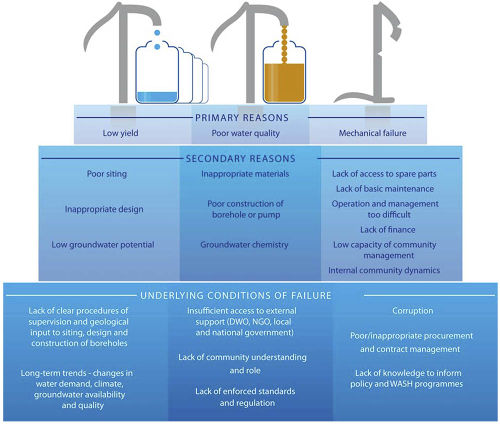OR/16/044 Rationale for developing a functionality asssessment framework
| Wilson P, Bonsor H C, MacDonald A M, Whaley L, Carter R C, Casey V. 2016. UPGRO Hidden Crisis Research consortium: initial project approach for assessing rural water supply functionality and levels of performance. British Geological Survey (BGS) Open Report, OR/16/044. |
 |
Understanding and documenting the functionality of HPB’s has been considered for at least the last 30 years. Arlosoroff et al. (1987)[1] recognised that there was a growing number of HPB’s that were broken down and abandoned, or functioning much below capacity. Despite the significant contribution that this project made to the standardisation of hand‐pumps, the issue of poorly functioning HPB’s has continued.
The Millennium Development Goals (MDGs) established in 2000 served as a catalyst for significant investment in rural water services with a focus to increase water supply coverage. The percentage coverage of rural population in Africa with access to improved water sources, other than piped supply, has since increased from 44 to 52% between 1990 to 2010 (JMP 2012). Anecdotal evidence, and studies since undertaken by national governments, donor organisations and implementing bodies to determine if this investment has produced the intended benefits indicate, however, around 35% of improved water sources are non‐functioning at any one time, and many fail for the first time within only a few years of installation, thereafter entering a cycle of failure and repair, or are abandoned (Rietveld et al. 2009[2], RWSN 2009[3], Lockwood et al. 2011[4]). As a result, the original investment and the intended benefits — improved health, nutrition, time savings, and education — are ultimately lost (Hunter et al. 2012[5], UN 2013[6]). Moreover, evidence suggests these breakdown rates have remained stubbornly high at between 30 and 50% over the last 40 years (McPherson and McGarry 1992[7]; Lockwood and Smits 2011[8]), despite various moves towards new community management and demand responsive approaches in the 1980s to try to improve sustainability of improved supplies.
Water point failure and functionality is a multi‐faceted, multi‐layered issue, with growing complexity as we look beyond the immediate causes of failure. A functionality pathway includes (Bonsor et al. 2015[9]): primary causes (e.g. mechanical failure, reduced yield, poor water quality); secondary causes (e.g. geology, poor siting, lack of spare parts, basic maintenance, local governance arrangements); the underlying conditions (including the institutional, financial and social factors that shape an environment in which failure is more or less likely); and long term trends (e.g. changes in demand for water, evolution of governance arrangements, reduction in regional groundwater availability, climate change, deterioration of water quality). This hierarchy of factors and underlying conditions to functionality are illustrated in Figure 2.
The new Sustainable Development Goals (SDGs) set a much stronger focus on sustainability of water services, and have highly ambitious goals to achieve universal access to safe and reliable water for all by 2030 (UN 2013)[6]. For WASH investment and policy to be able to deliver lasting benefit, it is essential the research community, donors and practitioners alike can begin to understand the inter‐related causes of water point failure and the actions that need to be taken to mitigate the risks. Water point functionality is only part of this story and three major research projects in the past 8 years — WASHCost, Triple S and Value For Money — WASH (VFM–WASH) — have examined different aspects underlying the sustainability of water services, (Triple‐S 2009[10], Cross et al. 2013[11], Ross 2015). All three have highlighted the need for clearer definitions of water point functionality in order to be able to understand, and move towards, improving service sustainability.

References
- ↑ Arlosoroff, S, Tschannerl, G, Grey, D, Journey, J, Karp, A, Langenegger, O, and Roche, R. (1987). Community Water Supply: the handpump option. Rural Water Supply Handpumps Project, UNDP/World Bank, The World Bank, Washington D.C., USA
- ↑ Rietveld et al. 2009 Phys Chem Earth: 34: 43–9
- ↑ RWSN 2009. Handpump Data in sub‐Saharan Africa
- ↑ Lockwood H, Smits, S. (2011). Supporting Rural Water Supply: Moving Towards a Service Delivery Approach Practical Action Publishing, 200 pp.
- ↑ Hunter et al. 2012 PLoS Med Water Supply and Health
- ↑ 6.0 6.1 UN Water 2013 A Post‐2025 Global Goal on Water. 2013
- ↑ McPherson, H J, and McGarry. 1992. International Journal of Water Resources Development, 3; 23–30.
- ↑ Lockwood H, Smits, S. (2011). Supporting Rural Water Supply: Moving Towards a Service Delivery Approach Practical Action Publishing, 200 pp.
- ↑ Bonsor H C, Oates, Chilton, P J, Carter, R C, Casey, V, MacDonald, A M, Calow, R, Alowo, R, Wilson, P, Tumutungire, M, and Bennie, M. (2016). A Hidden Crisis: strengthening the evidence base on the sustainability of rural groundwater supplies — results from a pilot study in Uganda. BGS Open Report, OR/16/019, pp 85.
- ↑ Triple‐S (2009) Providing reliable rural water services that last. Triple‐S Briefing Note, November 2009, pp5
- ↑ Cross, P, Frade, J, James, A J, Trémolet, S. (2013). "WASH Cost End‐of‐Project Evaluation." IRC End‐of‐Project Evaluation Report.